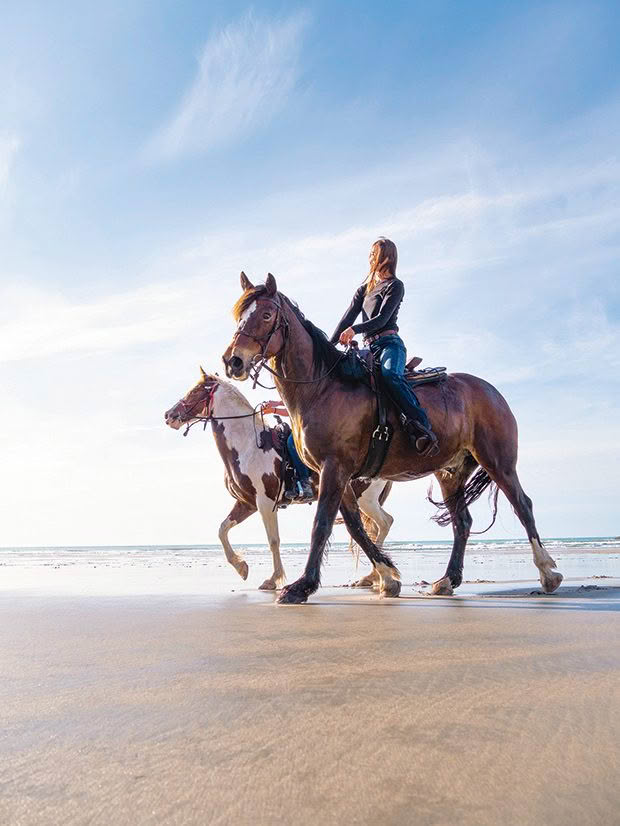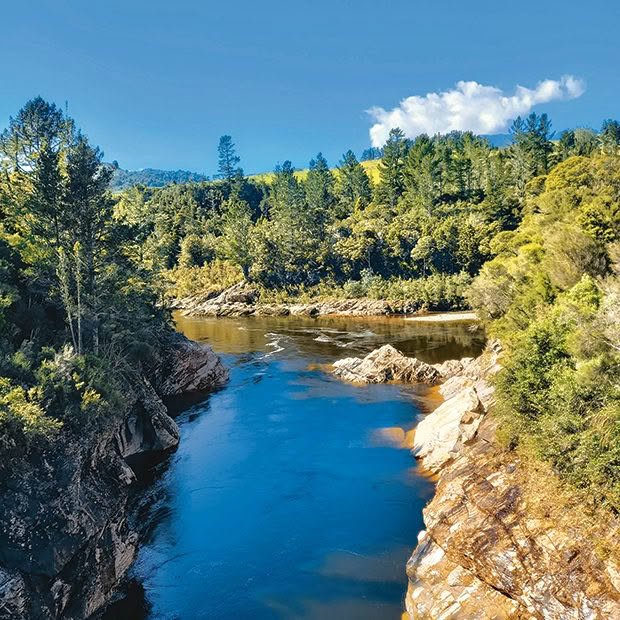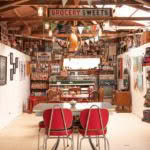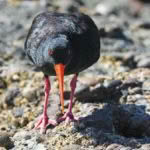Collingwood is a treasure trove of sunny delights

The caves and massive rock arches at Wharariki Beach are known worldwide, not least because they were a Windows 10 desktop wallpaper image. It’s a good 20-minute walk from the car park to the beach, but the rewards are legion. Aim to arrive at low tide to better access the caverns and arches and explore the rock pools. As the beach is on the western coast, at the base of Farewell Spit, it’s a reasonably robust surf experience, so swimming is not advised.
The road to Tākaka is one of Tasman’s less travelled, and the road past that town to Collingwood even less so. But there are treasures a-plenty in this shining spot of Golden Bay.
Words: Lee-Anne Duncan
The road from Tākaka ends abruptly with an expansive view of the Aorere River and the Western Ranges. It also presents a binary option — hang a left for the Farewell Spit and the Heaphy Track or a right for Collingwood. Most turn left, heading to the sandy tip of the South Island or the four-day Great Walk, leaving Collingwood no more than a glint in the rearview mirror. That’s assuming they make it past Tākaka, and most visitors don’t.

Marvel at the rock formations, take in their reflections in the water and giggle at the seals lounging around the colony (remembering to stay at least 20 metres away).
That’s a shame because this tiny town where the Aorere flows into Golden Bay is my new favourite place in New Zealand. It’s small, for sure, but it once had big ambitions. When gold was discovered in the 1850s, the town — then called Gibbstown — was touted to be the country’s capital. But when the gold dwindled, so did the town’s aspirations. Today’s visitors will likely have about as many fingers as Collingwood has streets. (Learn about the town’s past in the Collingwood Museum in the old council buildings on the main road.)

Save the swim for Pākawau Beach on the journey back — aim for high tide this time — sweetened with an ice cream from the Pākawau Beach Camp.
I hadn’t been over Tākaka Hill in nearly three decades, despite many trips to Tasman Bay and Nelson, daunted as many tourists are by the mountain between Tasman and Golden Bays. True, it’s a solid hour to wind up and over into the Tākaka Valley. But, where the Tasman Bay side is all hop-scented gentility, Golden Bay — Collingwood and the Aorere Valley in particular — is windswept and interesting. People here march to their own beat, and everyone, even the check-out operators at the surprisingly well-provisioned Collingwood On The Spot, are lift-your-heart friendly. The bay has enormous beaches for rambling — but beware, the speed of the incoming tide (tides can flow out 10 kilometres at their peak) can force you to run to keep your feet dry.

Cape Farewell, the northernmost point of the South Island, so-called as it was Captain Cook’s last glimpse of New Zealand. The view exemplifies the rock arches sculpted from the quartz sandstone at nearby Whakariki Beach. The brave and fit might venture east on a clifftop walk from here to the Pillar Point lighthouse or west to Wharariki Beach.
After visiting Collingwood for a large family get-together last summer, I’m convinced Collingwood is worth that drive and is an excellent base for adventures in this area. And there is plenty on offer, as there’s everything here.

Horse riders can explore that beach and the hilltops surrounding the cape with one of Cape Farewell Horse Trek’s many tours, including a ride on Pūponga Beach at Golden Bay.
The Langford Store, just 20 minutes from Collingwood up the Aorere Valley has the look of an old-timey film set. That’s not surprising as in earlier days Sukhita Langford — the third Langford to stand behind the counter — was a prop buyer and set dresser.
Once merely the area’s general store and post office, Sukhita has grown The Langford Store into the local grocer, sweet shop, tearooms, museum, and antique boutique. “I’ve always been into buying treasures,” she says. And most of her treasures are for sale, perhaps even the ones that aren’t. “If customers want something, it’s worth asking as I might say yes in a weak moment.”

That applies even to the antique bone china delivering one’s scone and cup of tea — and one simply must order a scone with cream and jam as they’re the best this side of Devonshire. Sukhita doesn’t claim credit for those, as her husband, Will Hutchison, is the one banging out the baking.
“He’s an absolute legend”, says Sukhita, adding that he’s the reason they could make such a go of the store after she took over from her aunt Lorna Langford in 2008. At that stage, Lorna had been running the store and adjoining post office for 60 years after taking the reins from her postmaster grandfather — Sukhita’s great-grandfather — in 1947.
Dunedin-born Sukhita had holidayed at the store with her family since a child, often helping her aunt with stock-taking. “Lorna would say to my mother, ‘I wish I could find someone to take the store on’, and one day my mother said, ‘What about Sukhita?’ I’d always had a daydream to live here, doing my art.”
Today, as well as still operating the post office, and running out teas and scones, cakes and coffees, Sukhita sews Kiwiana-themed hats and aprons and creates artworks, also for sale at the store. The Langford Store also happens to have what must be the country’s best long-drop toilet. It’s clean and sweet smelling, and if using a long-drop is a mystery there’s a convenient how-to guide.
When Sukhita’s great-grandfather built the store in 1928, it was the mainstay of then-busy Bainham. Now it’s mostly a tourist destination, or an ice cream stop before or after a dip at the nearby Sainsbury Falls, but Sukhita is as determined as her aunt Lorna was to keep the store going for the community and visitors alike. “I think people want the magic of sitting here. The world is so sped up these days, but not down here.
Here, they can just sit and look at the mountains and the beautiful valley, and soak in the nostalgia.”
TAKING THE PLUNGE

To conjure up the ultimate river swimming hole is surely to imagine the Salisbury Falls. The waterfall itself is modest but perfectly formed and served as a backdrop in the final movie in The Hobbit trilogy. But, for me, its beauty and novelty are submerged by the nearby swimming hole in the Aorere River.
The deep emerald expanse is not for the faint-hearted — deep and very cold but clean and peaceful. The falls and the swimming hole are popular, and many locals come and set up for the whole day (despite the sandflies), but there’s plenty of room to sit and to swim — and to gasp as fearless teenagers plunge from the high rocks into the seemingly bottomless water. If time or mobility is an issue, or to stay sandfly-free, there’s a great view of the swimming hole from the Salisbury Bridge, but it’s one lane so watch out for traffic.
FAREWELL SPIT

Farewell Spit began to rise from the sea at the end of the last ice age, about 14,000 years ago. The kiwi beak-like curve at the top of the South Island is sediment from West Coast rivers transported north on coastal currents and deposited to form the spit. Quartz and granite from those rivers have been crushed to silvered sand that slides like silk between fingers and toes. Going barefoot at some stage is a must.
This 35-kilometre sandspit feels simultaneously ancient and youthful. A visit means touching fossils many, many thousands of years old, or quietly appreciating new life as birds, such as gannets from the colony at the spit’s tip, fly long and low along the beach, back to feed their young.
Visiting the spit is restricted to the first four kilometres for those on foot, with the only authorised access past that point — and the only motorised access anywhere on the spit — allowed via Farewell Spit Eco Tours. The tours are tide-dependent, which often means a very early start from Collingwood. And it’s a brilliant time of the day to catch extraordinary bird life totally indifferent to the slowly moving bus. This tour is also the only way to visit the lighthouse, which still beams its warning across the bay. It’s a humbling experience to roam around the still-standing lighthouse families’ houses, imagining what life was like for those who once tended the lighthouse around the clock, as nature’s timeless rhythms revolved around them.
WALK
There are many bush, beach and mountain walks around Collingwood. Start with a stroll down Collingwood Beach at low tide, perhaps as far as Milnthorpe Park, to get lost (not literally — make sure to pick up one of the available maps) in the park’s series of named trails through regenerating bush. Milnthorpe Park is a community-managed project going — and growing — since 1974, and a donation is appreciated. Leave some energy to explore the neighbouring Parapara Inlet. For a day’s outing, walk the first few kilometres of Farewell Spit, drive over to Wharariki Beach to walk along this sandy, seal-rich stunner, or go bush and walk some or all of the Kaituna Track down the Aorere Valley.
STAY

If travelling with a large group — or for those searching for a wedding venue — Zatori is just the place. Not only does it sleep up to 25 comfortably and offer a commercial kitchen (and even catering), there’s a spectacular view of the Aorere River estuary from its huge deck. For smaller groups, try the Station House Motel in the old police station or the Collingwood Holiday Park (left) with its unsurpassed view of the estuary’s ebb and flow.
EAT

The Courthouse Café offers great food, coffee and service, and is open 8am until 3pm every day, with heaps of seating inside and out. Make time to pop into Sue Dasler Pottery, accessed from the café’s garden. The Collingwood Tavern is where to go for takeaways, and its freshly made fried chicken is recommended. Also, try Bacca Bakery and the Mussel Inn, both back towards Tākaka.
Love this story? Subscribe now!
 This article first appeared in NZ Life & Leisure Magazine.
This article first appeared in NZ Life & Leisure Magazine.







